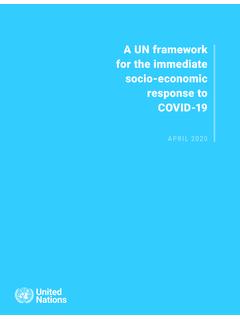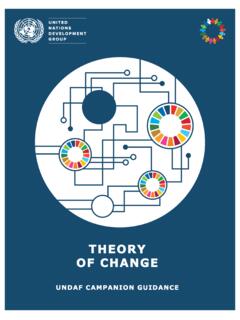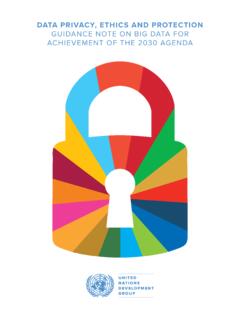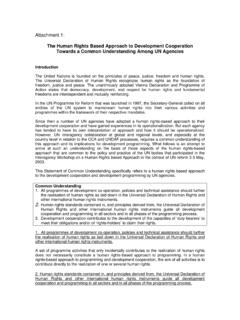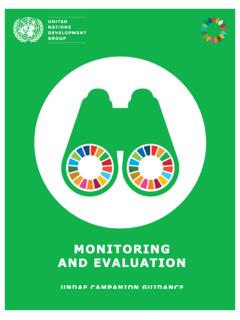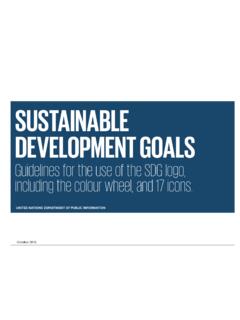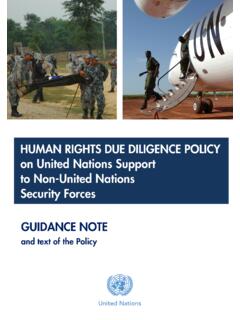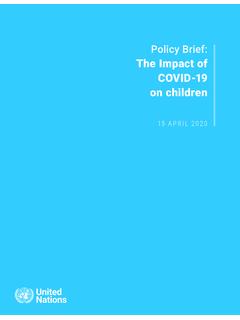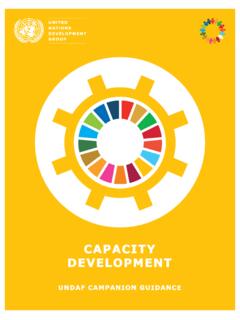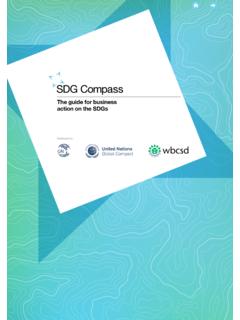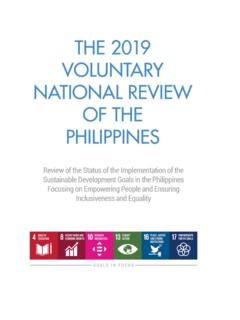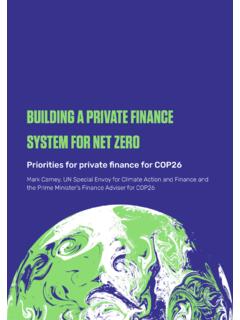Transcription of UNDG Mainstreaming the 2030 Agenda Reference Guide 2017
1 1 | P a g e 2 | P a g e Mainstreaming the 2030 Agenda for Sustainable Development Reference Guide to UN Country Teams March 2017 Update Revisions This March 2017 update to the Mainstreaming Reference Guide includes the following: New case examples of early country implementation of the 2030 Agenda provided in each section. New Section B9 on guidance for countries in complex situations. An executive summary for quick Reference and communication. Updates to Section B1: Raising Public Awareness to include recent information and tools from the SDG action Campaign Revisions to Section B3: Adapting sdgs to National, Sub-national and Local contexts to include guidance on mapping SDG interconnections and to provide more information on foresight methods for planning.
2 Revisions to Section B6: Financing and Budgeting for the Future to include more information on financing SDG implementation. Updates to Section B7: Monitoring, Review and Accountability to include updated information on Voluntary National Reviews and the role of the High Level Political Forum. Listing the Mainstreaming practice of Creating Horizontal Policy Coherence among those which should be initiated now (previously listed as initiate over time ). Case examples of early efforts revealed that many countries are creating institutional mechanisms to coordinate SDG planning at the early stages. Previous versions of the Reference Guide include: February 2016: This version incorporated feedback from UN Agencies and UN Country Teams received since the publication of the Interim Mainstreaming Reference Guide in October 2015.
3 October 2015: Interim Mainstreaming Reference Guide published. Acknowledgements This document was compiled by Darren Swanson ( ) under the guidance of a Reference group constituted under the Sustainable Development Working Group of the United Nations Development Group. United Nations Development Group 2016 The analysis and recommendations of this document do not necessarily reflect the official views of the United Nations, its agencies or its Member States. Textual material may be freely reproduced with proper citation and/or attribution to the authoring agencies, as appropriate. All rights reserved for photographic or graphical material, which cannot be reproduced in any digital or traditional format without permission except as part of this publication (such as when reposting a pdf file with attribution).
4 3 | P a g e Contents EXECUTIVE ..4 PART A: INTRODUCTION Section A1: Purpose and Context .. 9 Section A2: The 2030 Agenda for Sustainable Development and sdgs .. 11 Section A3: MAPS: Mainstreaming , Acceleration and Policy Support for the Implementation of the 2030 Agenda .. 14 Section A4: How to Use this Reference Guide .. 16 PART B: GUIDANCE Section B1: Building Awareness .. 20 Section B2: Applying Multi-stakeholder Approaches .. 32 Section B3: Adapting sdgs to National, Sub-national and Local Contexts .. 43 Section B4: Creating Horizontal Policy Coherence (breaking the silos) .. 63 Section B5: Creating Vertical Policy Coherence (Glocalizing the Agenda ) .. 74 Section B6: Financing and Budgeting for the Future.
5 83 Section B7: Monitoring, Reporting and Accountability .. 100 Section B8: Assessing Risk and Fostering Adaptability .. 114 Section B9: Mainstreaming the 2030 Agenda in Countries in Complex Situations .. 125 4 | P a g e Executive Summary INTRODUCTION The 2030 Agenda for Sustainable Development and its 17 global Sustainable Development Goals ( sdgs ) and 169 targets were adopted by all Member States of the United Nations in September 2015. It officially came into effect on January 1st 2016 and is to be achieved by 2030. The 2030 Agenda applies to every country. This Reference Guide for Mainstreaming the 2030 Agenda for Sustainable Development was created by the United Nations Development Group (UNDG) to assist UN Country Teams in helping Member States with adapting the global sdgs to national contexts1.
6 This updated version includes new tools and country examples of Mainstreaming and guidance for countries affected by conflict and fragility. The UNDG is a consortium of 32 UN agencies created by the Secretary General in 1997 to improve the effectiveness of UN development activities at the country level. The Reference Guide is a product of the UNDG s new MAPS approach for Mainstreaming -Acceleration-Policy Support. Under MAPS, UN agencies provide coordinated support to Member States in implementing the 2030 Agenda . WHO SHOULD USE THIS Guide ? The Mainstreaming Reference Guide was created for UN Country Teams who are called upon by Member States for assistance with adapting the global sdgs to national contexts and Mainstreaming them into national development plans and planning processes.
7 The Guide presents a comprehensive set of eight practice areas for Mainstreaming the 2030 Agenda along with a special section for countries in complex situations. With specific implementation steps, practical tools, and case examples from developed and developing countries, the Mainstreaming Reference Guide is directly useful to Member State governments who are interested in adapting the global sdgs to their national contexts. THE EIGHT PRACTICE AREAS The Reference Guide includes eight practice areas as opportunities for Mainstreaming the 2030 Agenda and sdgs into national strategies, plans and planning processes. These practice areas all relate to the traditional plan-do-check cycle of strategic planning.
8 Of the eight practice areas, five are particularly important to initiate in the early stages of Mainstreaming . These areas include: Raising Public Awareness; Applying Multi-stakeholder Approaches; Reviewing Plans and Adapting the sdgs to National Contexts; Creating Horizontal Policy Coherence; and Monitoring, Reporting and Accountability. These five areas represent key opportunities for Member Steps to mainstream the 2030 Agenda and sdgs . The remaining three practice areas including Achieving Vertical Policy Coherence, Financing and Budgeting for the Future, and Assessing Risk and Fostering Adaptability, are critically important for deep Mainstreaming and accelerating progress toward achieving nationally adapted sdgs by 2030.
9 1 Available in English, French and Spanish at: 5 | Page Practice Area #1: Raising Public Awareness of the 2030 Agenda and sdgs Building public awareness of the sdgs and their relevance to national strategies and plans is a critical initial and ongoing step in successful implementation. The practice areas outlined in the Reference Guide include: A. An introductory workshop series: to sensitize government officials and stakeholders to The 2030 Agenda and sdgs ; B. Creating a public awareness campaign: to communicate The 2030 Agenda and sdgs to the general public, including women, children, youth, and others as applicable, such as internally displaced persons, and non-nationals such as refugees and stateless persons; and C.
10 Opportunity management: to leverage other government and UN-sponsored meetings and forums to sensitize government officials and stakeholders to The 2030 Agenda and sdgs . Featured Tool: The SDG action Campaign Toolkit Practice Area #2: Applying Multi-stakeholder Approaches for Reviewing National Plans and Adapting the Global sdgs to National Contexts Core to the quality and legitimacy of a society-wide Agenda is the application of multi-stakeholder approaches for policy development and implementation to encourage and facilitate partnerships between government and nationally and sub-nationally active stakeholder networks of civil society, universities, think tanks, the private sector and other development actors.
